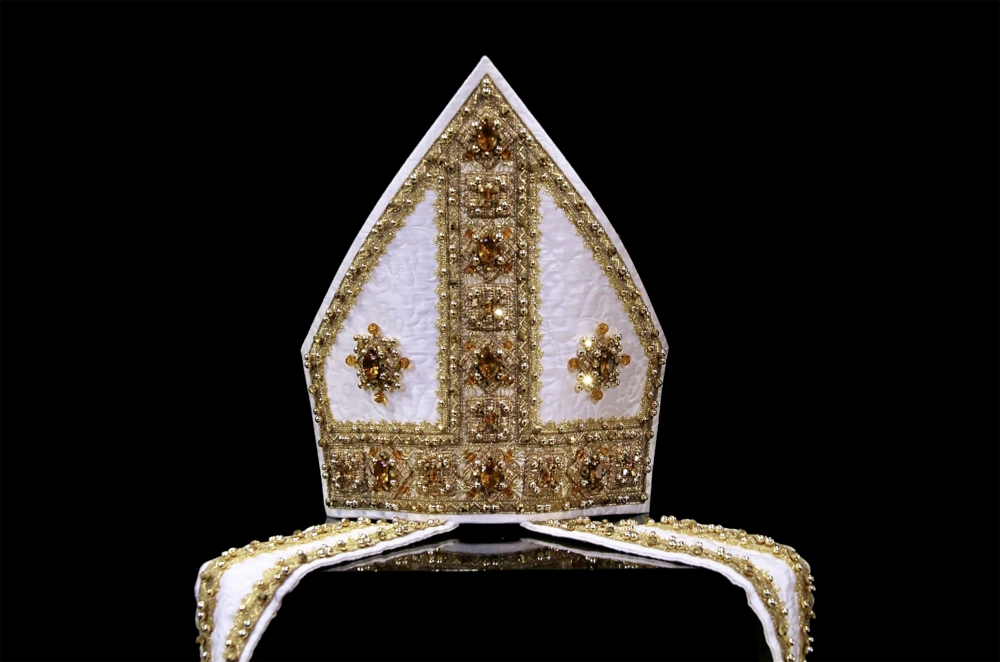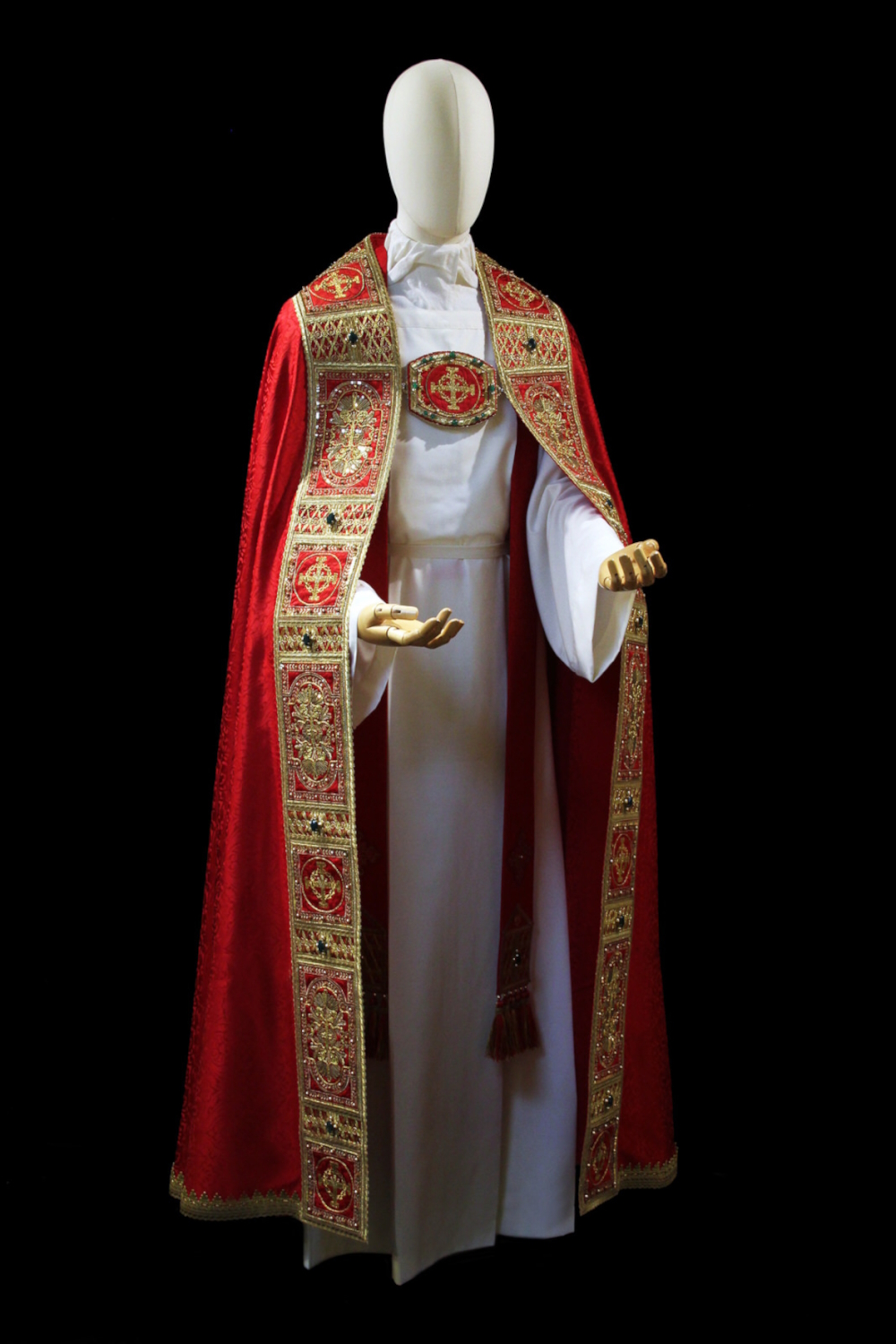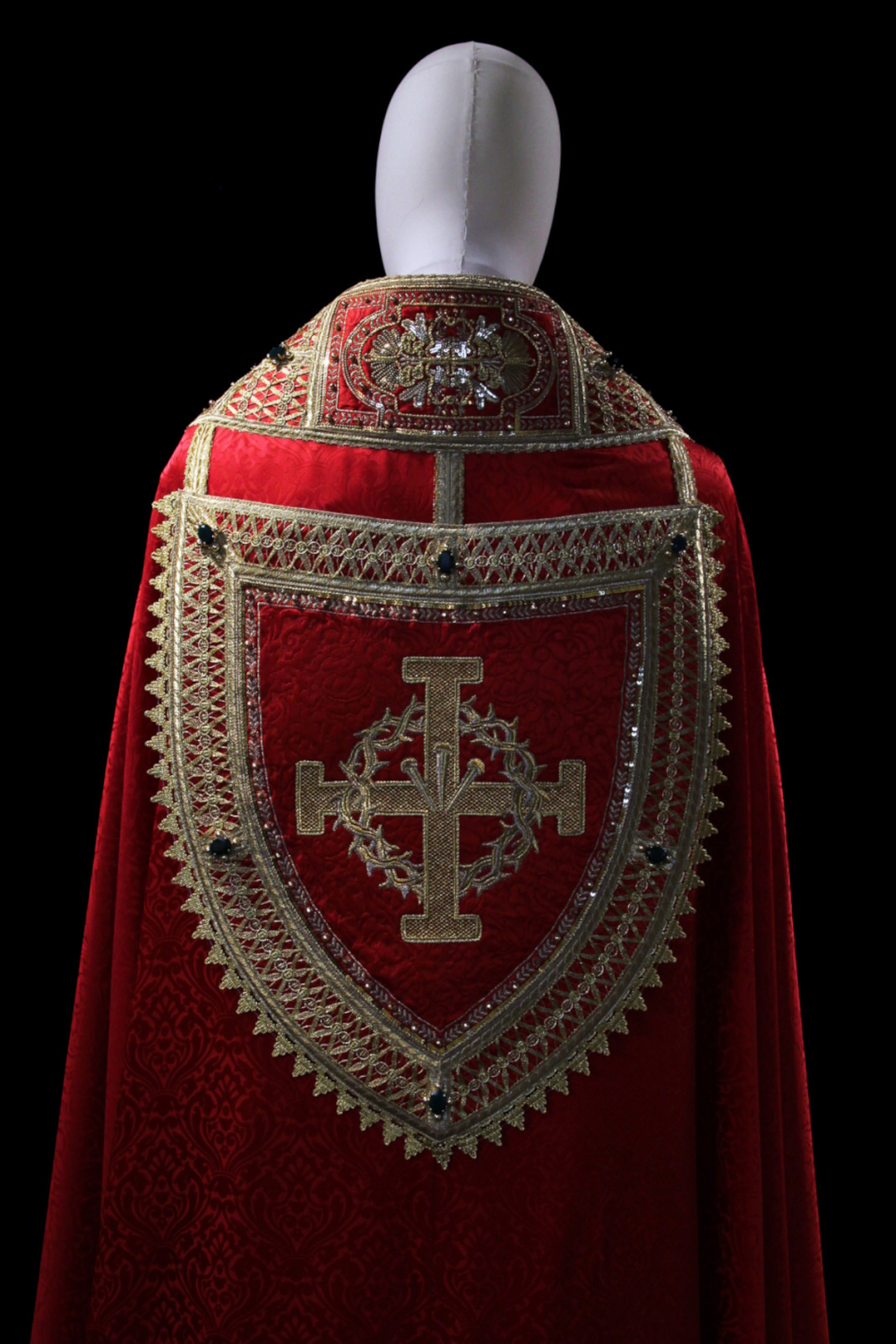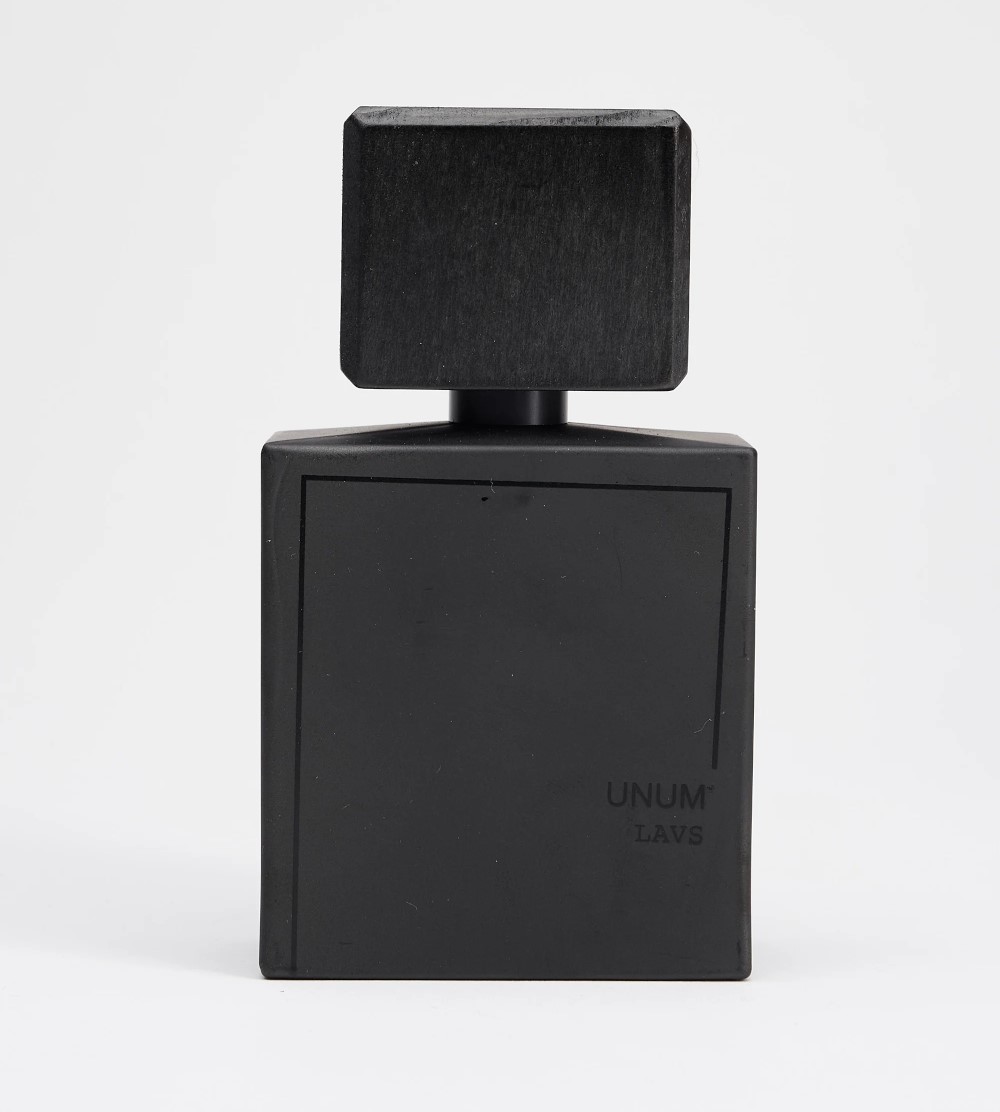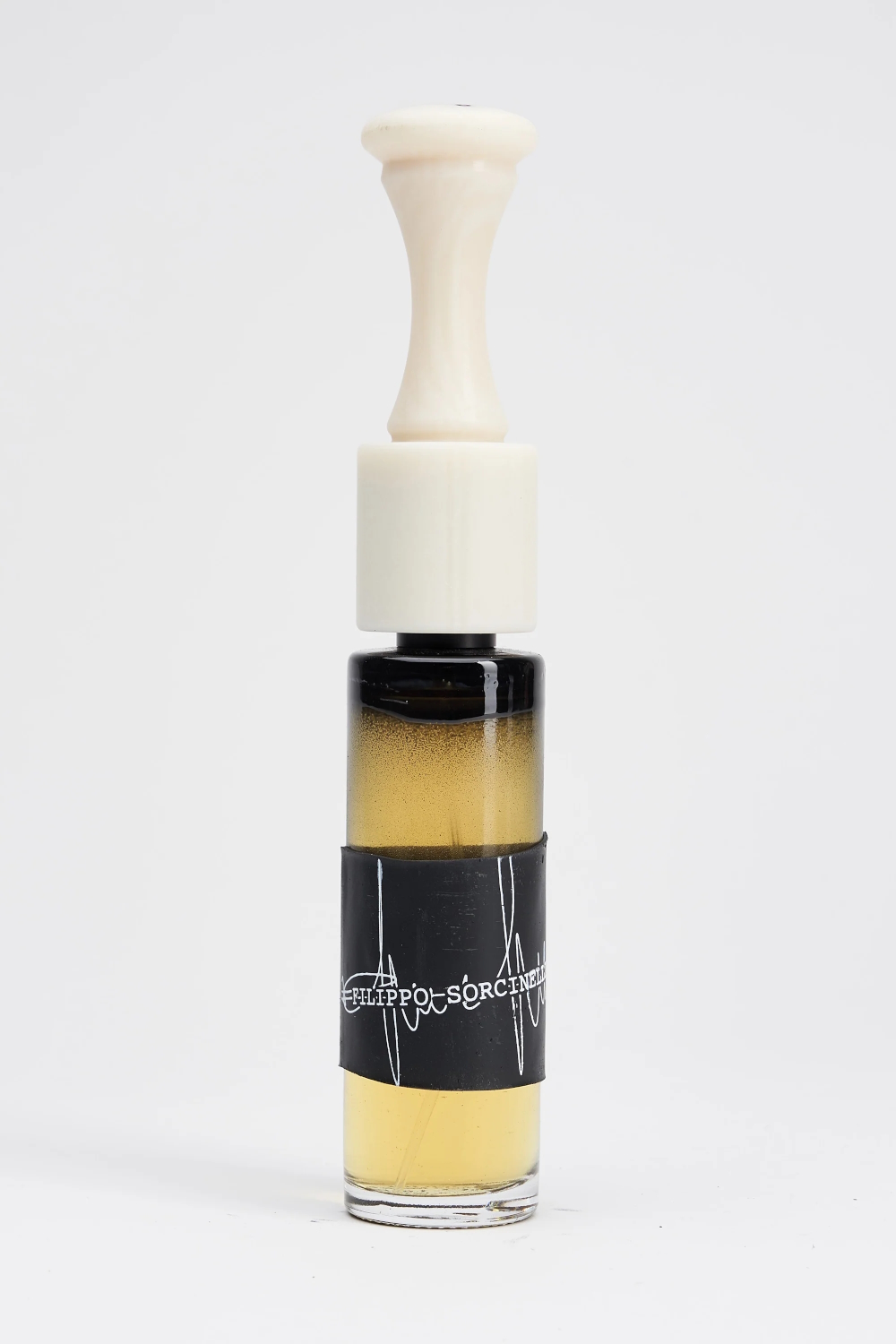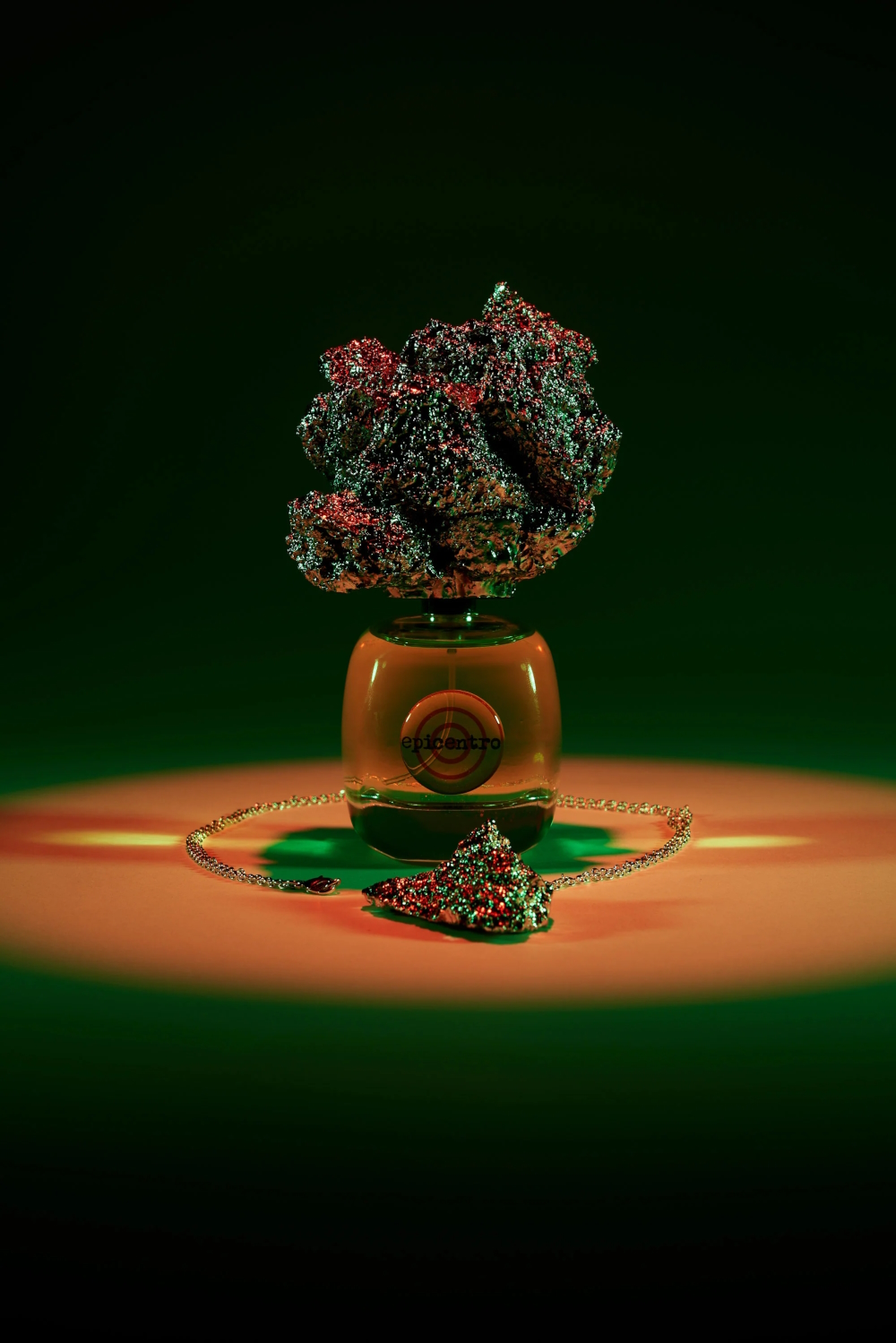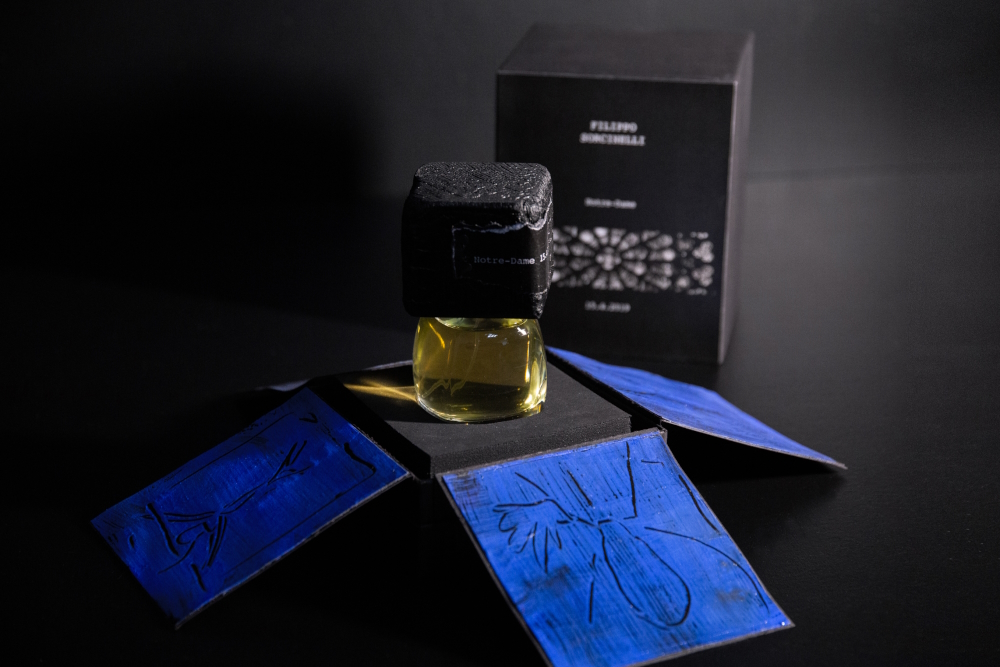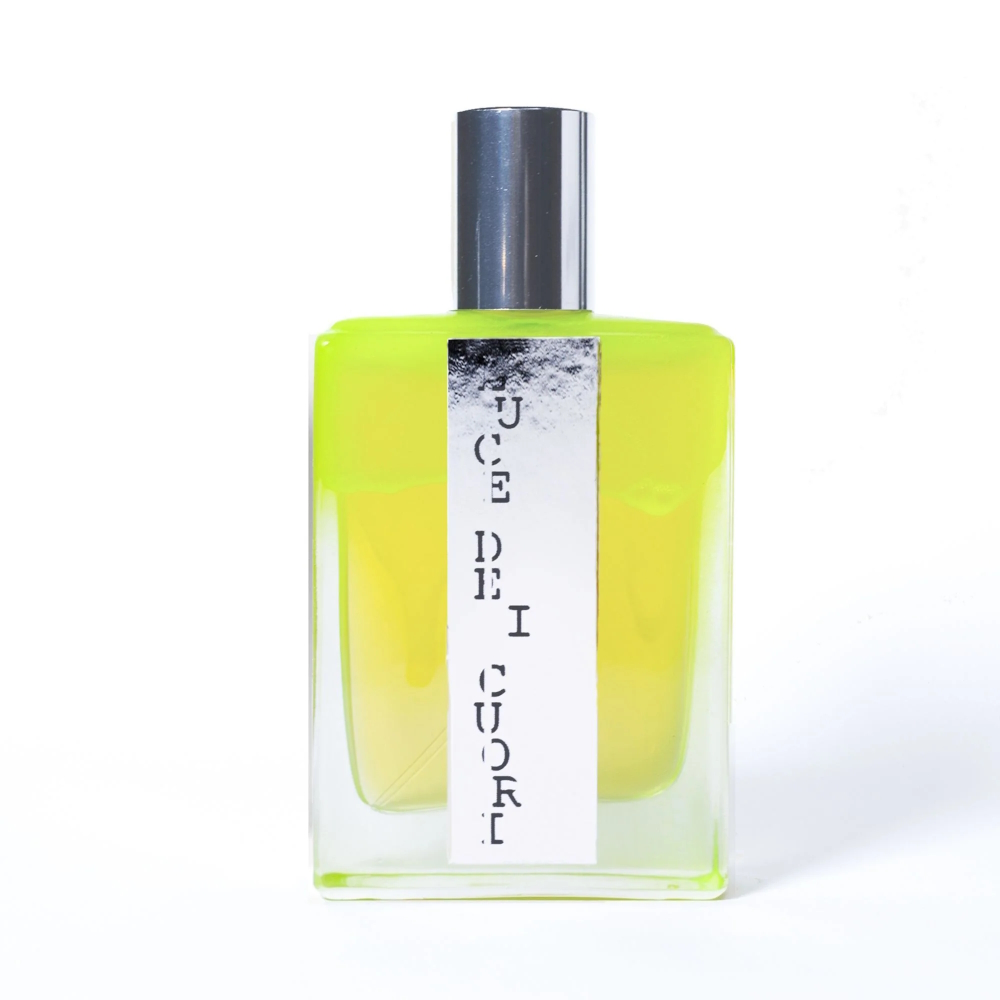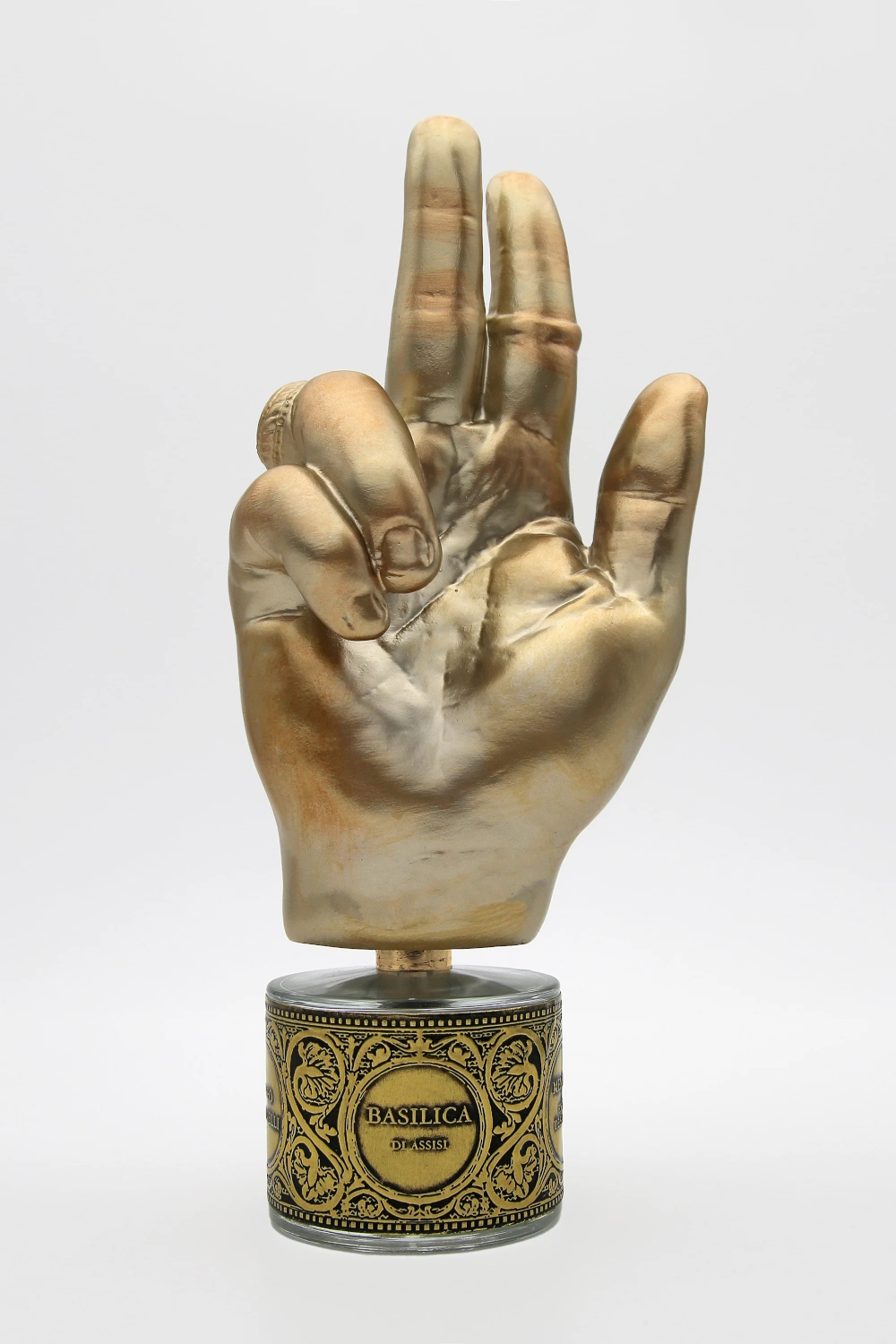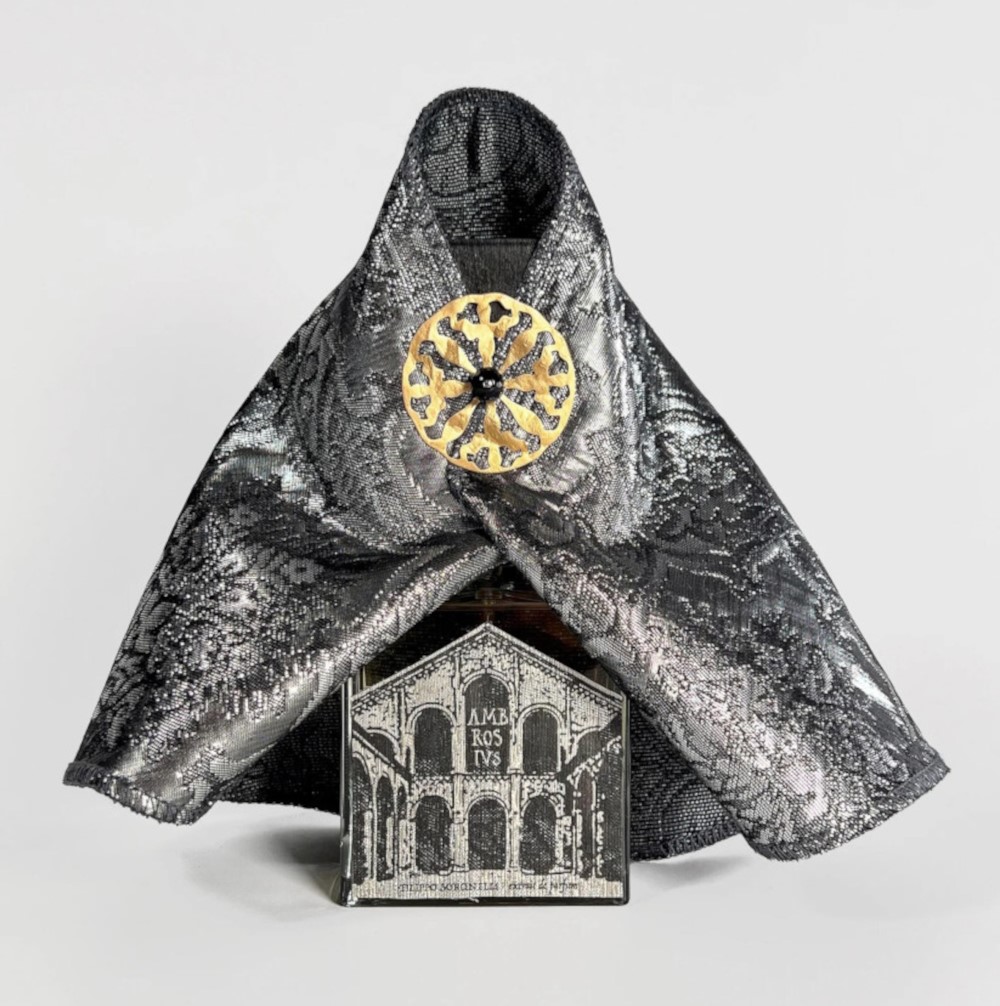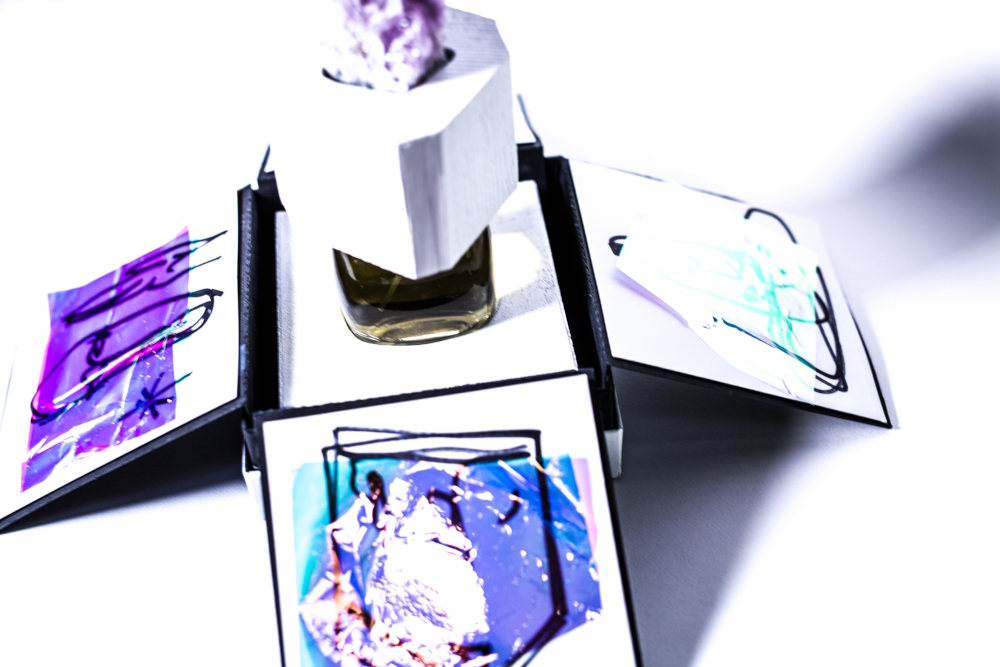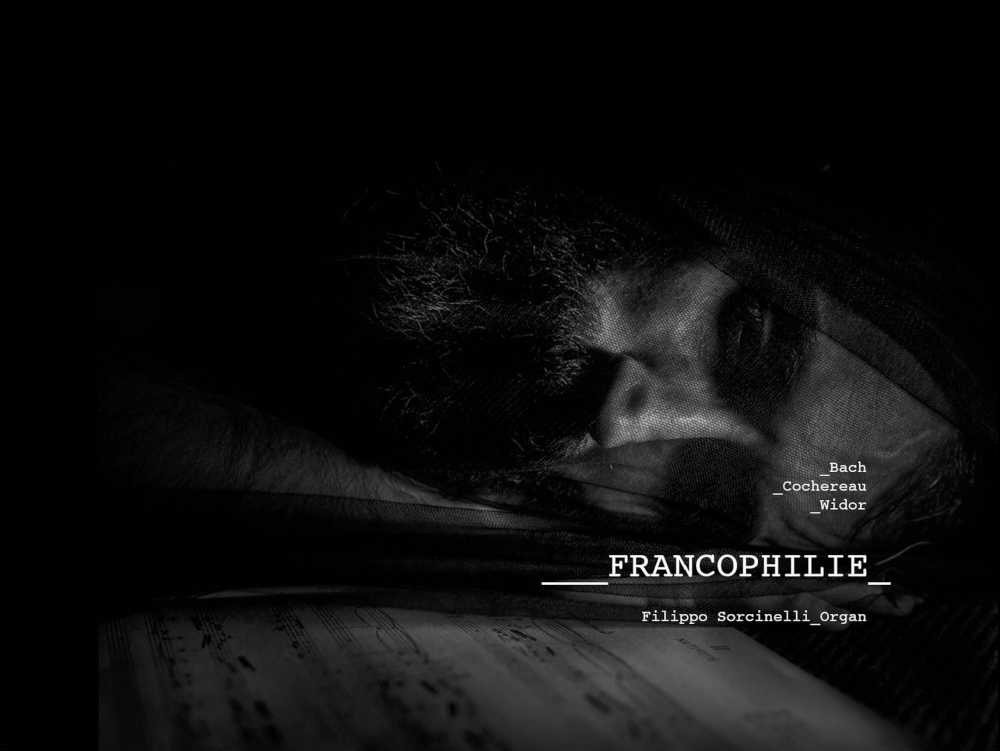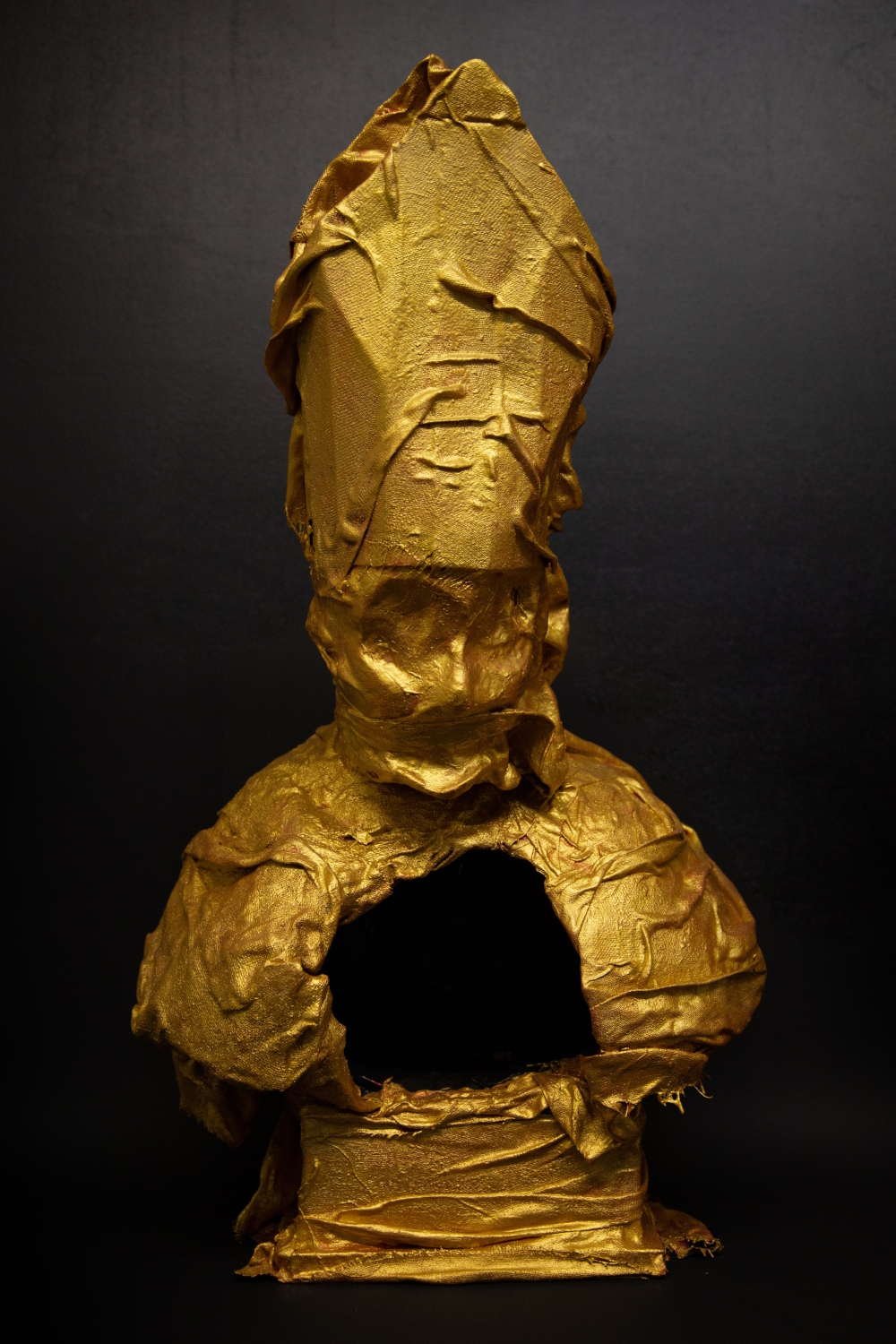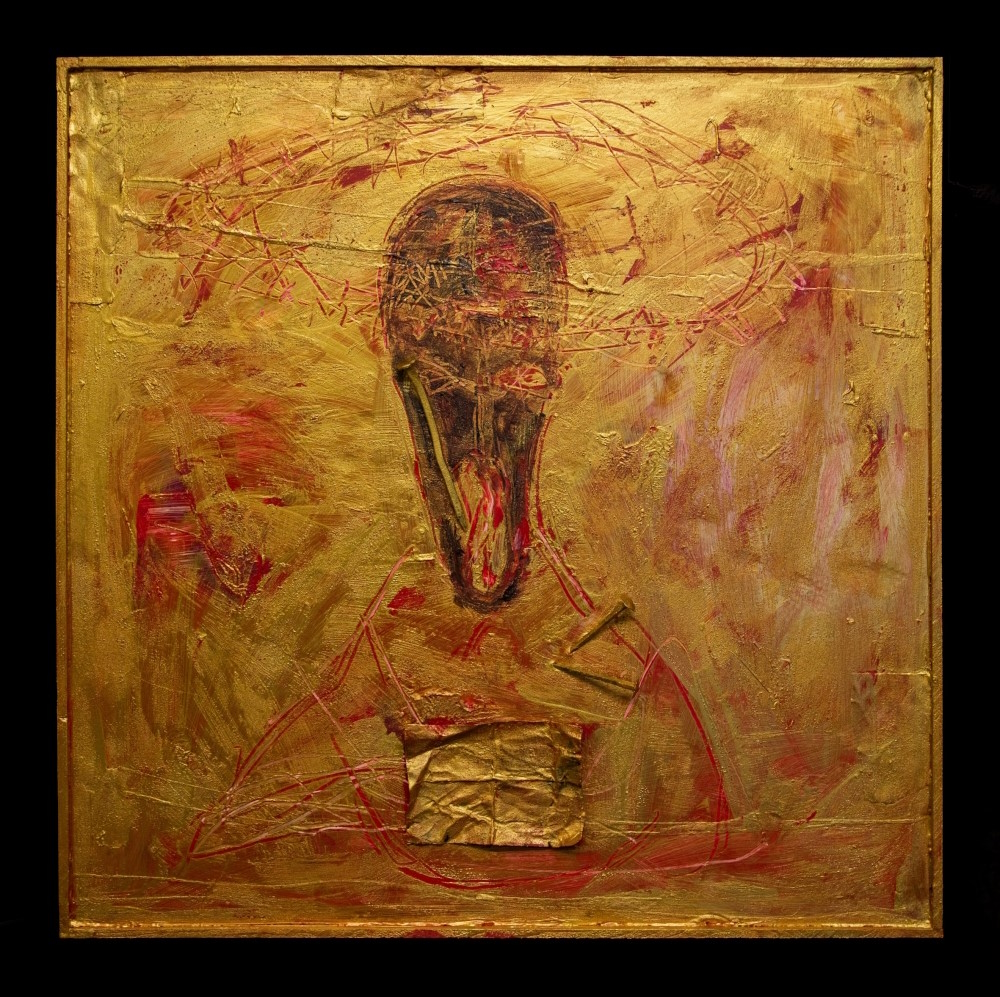Filippo Sorcinelli
conceptual artist between history, art and spirituality
Italy
Numerous robes for Pope Benedict XVI. (04/2005 – 02/2013) and for Pope Francis's inaugural pontificate mass (19/03/2013). Besides being the founder of a couture workshop for church clergy, this multi-faceted creative is also a niche fragrance perfumeur as well as „a painter, photographer, musician, and conceptual post-modernist artist“ (kafkaesqueblog.com). „My research is orientated on signs and symbols of the immense medieval artistic heritage“, the Italian told tattoolife.com. For him as „a special kid“, growing up in „an extremly simply, but supportive family“, it all began as a young teenager – in Gothic and Romanesque cathedrals!
Filippo Sorcinelli
conceptual artist between history, art and spirituality
Italy
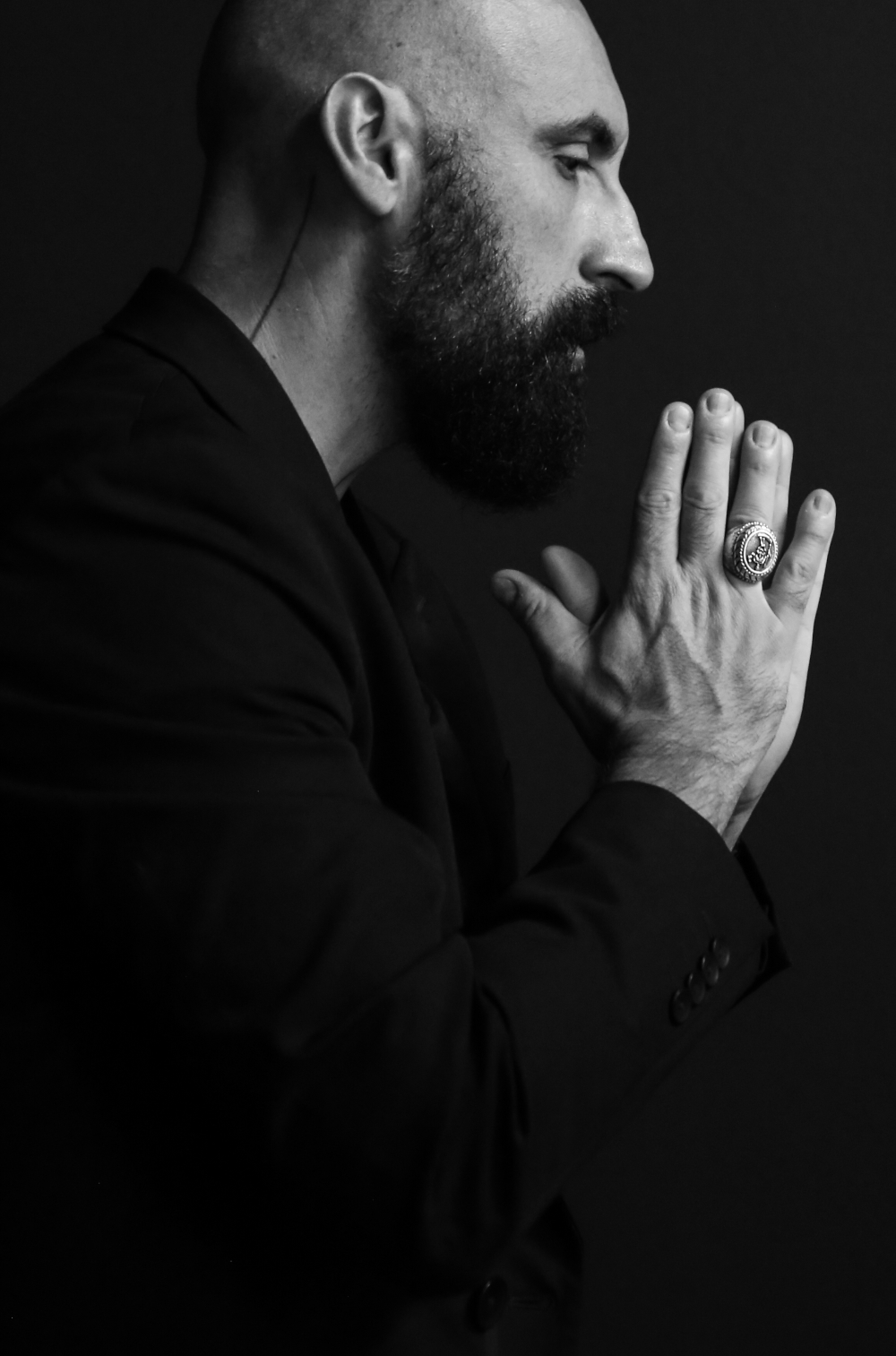
Being just 13 years old Filippo Sorcinelli (* July 1st, 1975 in Mondolfo) started as the organist at Fano Cathedral. He held this position at the principal church in this city of the Marche region up until 1998 and then played at Benedetto del Tronto Cathedral from 2007 to 2013 as well as at the Rimini Cathedral in 2012. „These early contacts with Art and Beauty and their countless facets have overwhelmed, stigmatized my life forever: incenses, Gothic and Romanesque cathedrals, organ music, choirs, old and modern sculptures, sacred vestments, paintings and much more: all these solicitations have wrapped and preserved the emotions of an excited young heart“ (kafkaequeblog.com).
These were busy times for the young man back then. Besides his big responsibility playing the organ at the bishop’s pontifical celebration, he soon became „a student at the Art Institute in Fano. He graduated as Maestro d'Arte first in 1992 and at the same time studied at the Gioachino Rossini Conservatory in Pesaro until 1996. In 1997, he was awarded a scholarship by the Pio Sodalizio dei Piceni to specialise in Organ at the Pontifical Institute of Sacred Music in Rome“ (Wikipedia). But the instrumentalist who is particular appreciated for his ability to improvise on the organ didn’t pursue the obvious career. Instead of becoming a professional musician Filippo Sorcinelli founded LAVS atelier (Laboratorio Atelier Vesti Sacre) in 2001. „It is dedicated to the study, design and creation of sacred vestments, furnishings and accessories for the sacred liturgy“ (Website). Its excellent works are recognised worldwide and exhibited as well as part of various tv-documentaries on the designer.
2013 saw the foundation of UNUM, the art perfume house‘s first of various olfactory collections to come. Debuting with three fragrances - Opus 1144, Rosa Nigra and LAVS - caused quite a stir. The latter „was originally a room and clothing spray for the popes before being transformed into a scent for the skin. A number of people who love liturgical or churchy incense consider it the best incense fragrance ever made“ (kafkaesqueblog.com).
In 2015 this organist recorded „Francophilie“, His first album is dedicated to French music.
Come 2016: Filippo Sorcinelli launched a second brand: Extrait de Musique featuring „a collection of fragrances inspired by the fusion of organ music and church incense associated with High Mass. Specifically, each of the scents in the collection refers to individual organ stops or the wood of the Grand Orgue of Notre Dame Cathedral in Paris, which Sorcinelli, as tailor to the pope and a fervent organist himself, was allowed the rare honor of photographing and studying“ (takeonethingoff.com).
In 2020, he not only conceived and organised the permanent open-air art exhibition „Mondolfo galleria senzo soffitto/Mondolfo gallery without ceiling“ in the historic centre of the municipality of the same name, but designed a frangrance inspired by the 2016 Marche and Umbria earthquake. The proceeds of „Epicentro“ contribute to the reconstruction of the affected towns.
Twelve months onwards, Sorcinelli announced the fragrance „Note-Dame 15/4/2019“, linked to the fire that devastated the famous Paris Cathedral.
With such a wide selection of products available, it was time for him to open his first sacred art shop in Rome in 2021 (next to St Peter’s Square). It was the same year, when he launched the „Extrait de Perversion“-collection. It’s a social and olfactory investigation describing private and intimate moments of man“ (Wikipedia).
2022 brought the fragrances "Luce Dei Cuori"/The Light Of Hearts“ and "Dolcissimo Sollievo/Sweetest Relief“ „which explore themes of spirituality and inner peace.“
In June 2022 his first perfume flagship store was opened in Rome and the second one was opened in March 2023
In March 2023 his second flagship store was opened – this time in Milan, the economic capital of Italy and a global centre for business, fashion and finance.
Suprising that the much awarded creative still finds the time to realize himself artistically in various other genres – despite all his others engagements. „Creative freedom is the basis for generating a work of art“, he’s quoted on tattoolife.com. And that’s not all: „Nothing is causal, not even impulse, because I believe that every happening in this world is simply generated by another.“ Essentials elements of his work for him are „curiosity, consistency, truth and freedom. In other words: Beauty with a capital B!“
Filippo Sorcinelli lives in Mondolfo (Marche region) and works between there, Milan and Rome.
Interview June 2025
Essential elements of art: curiosity, consistency, truth, freedom and beauty
INTUITION/IMAGINATION
?: How does intuition present itself to you – in form of a suspicious impression, a spontaneous visualisation or whatever - maybe in dreams?
Intuition reveals itself as a vivid, unmistakable presence. It arrives when attention expands and everything becomes listening. It appears as I touch a fabric destined to become a sacred gesture, when my hands meet the material and read its history. It emerges as the organ vibrates in an empty church and the sound joins the breath of time. It manifests itself in workshops and daily life, among the scents of wood, incense, and drama, when a fragment of my memory becomes so clear it can open itself to others. Intuition opens like a fissure that reveals another possibility. It brings a precise direction, it enters with grace. It roots in the body before thought arises. It is a silent flame walking within. A vibration asking for space to exist, almost like a scar opening to let the thought of the world emerge. In that moment, the air changes, the gaze transforms, and the hands stop searching. That is where the ritual begins. That is where everything becomes necessary. That is where the gesture takes form.
?: Will any ideas be written down immediately and archived?
I always write. Every intuition finds its place through a word, an image, a gesture. Even the briefest deserves a trace, a passage. I use notebooks, scattered sheets, the back of a drawing. Any surface may contain a fragment. Some ideas transform immediately into projects, while others remain still, like deep seeds within time’s womb. They speak to me after years, when my inner world is ready to welcome them. Some grow slowly, nourished by memory and new experiences—like a fabric that must be touched before being sewn. My archives are inner maps, lived landscapes. They hold voices, errors, intuitions, scent fragments, titles of works yet to be born. They gather memory and desire, like a reliquary of the possible. Each written word carries a secret direction, and each noted gesture preserves the heartbeat of a future intention. For me, writing is already an act of creation. It is the first contact through which the idea begins to take form.
?: How do you come up with good or extraordinary ideas?
Good or extraordinary ideas rise from a crack, from an overflow, from a silence that has waited long enough. They emerge when something within leans outward. Often they originate from strong inner images, or from lived elements that have always belonged to me: a case bearing the weight of prayer, a garment worn down by liturgies, a scent reopening a buried memory. The true idea arrives discreetly, yet affirms its urgency. The extraordinary idea carries a spark that demands visibility. It appears during a solitary journey, in the dust of a sacristy, in the gestures of a perfume forming between glass, skin, and breath. Authentic ideas require embodiment. They do not suffice on their own. They demand listening, space, dedication. They become visions and call for form. They enter the world through matter, becoming vestments, installations, reliquaries, fragrances. Each lived idea follows a vertical, clear, and necessary trajectory. My role is to recognize, welcome, and return them to truth. I accompany them with respect. I welcome them as sacred visitors. I allow them to find their own pace and time. Only then can they reach others, as real questions do.
?: Do you feel that new creative ideas come as a whole or do you get like a little seed of inspiration that evolves into something else and has to be realized by endless trials and errors in form of constant developments until the final result?
Each idea arrives with a living structure. It comes as a body waiting to be inhabited. It carries a complete form, even when it remains hidden. My task is to give it space, protect it, and allow it to mature. Some emerge with immediate clarity, as if they have already found their skin. Others open over time, growing like wild herbs in the cracks of experience. I walk beside these ideas. I observe and listen. I accompany them as I would something sacred. I let time reveal their point of fulfillment. I recognize the inner rhythm of each without forcing. Every gesture, every sound, every material helps me understand when and how to give them form. Ideas do not get built—they reveal themselves. My role is to guard them until they offer themselves. Only then can I transform them into works.
?: What if there is a deadline, but no intuition? Does the first fuel the latter maybe?
Yes. The deadline creates a fertile container and provides orientation. Intuition finds energy in the limit. When urgency and vision meet, creation intensifies. Many of my days flow through creative rhythms that oscillate between artistic gestures and practical demands. The deadline becomes a rhythm that accompanies the depth of inspiration, defining a space where something must happen. When time takes shape, thought becomes form—like music seeking its score. The tension between passing time and burning thought creates intensity. Every project, every fragrance, every gesture born within this temporal frame answers life itself: incandescent, precise, necessary.
INSPIRATION
?: What inspires you and how do you stimulate this special form of imaginativeness?
Inspiration arises when I enter into contact with what pulses in the depths. I feel inspired by a dismantled altar, a forgotten or unusual object, dust suspended in light, the scent of fabric that once adorned a liturgy. Whenever a smell surprises me, a gesture returns, or a crack reveals beauty, I sense the stirring of imagination. I stimulate vision by remaining faithful to my rituals: listening, walking, sewing, composing, touching, suffering. My atelier is a spiritual space. My hands inhabit waiting, and my gaze recognizes beauty where it already exists, even when it asks for no attention. Memory inspires me, as does time layered upon objects, the movement of hands through the clay of drama, the scent left in fabrics after incense. I’m inspired by pain transformed, by tears that left a trace. Everything that vibrates without clamor generates a spark. I stimulate imagination by relating to these signs. Every day I repeat gestures that for me are liturgies: minimal actions that open thresholds. Thus, imagination finds a dwelling and allows itself to be inhabited.
?: How do you filter between ideas that are worthwhile pursuing and bad ones that you just let go of?
Authentic ideas are recognizable by their persistence. They return, seek space, and make themselves felt even when everything else is silent. They speak an inner language that the body understands before the mind. Some enter my thoughts like a breath that keeps moving without asking. Those remain. Others, more fragile, dissolve on their own. They brush the edge of awareness but generate no echo. I let them go with gratitude, as one does with things that merely touched the threshold of being. No idea is lost, yet only some demand to become matter. I do not use rational criteria or set frameworks. I trust in listening: if an intuition resonates with my deepest vision, I follow it. If it kindles poetic urgency, I embrace it. Ideas worth pursuing know how to wait, but do not retreat. They carry rhythm, light, a precise scent. In my creative world, every choice is shaped by this inner fidelity. I recognize what vibrates. I listen to what burns. And I trust the gesture, which always knows where to go.
?: Does an idea need to appeal to you primarily or is its commercial potential an essential factor?
An idea must speak to me first. It must ignite a truth that concerns me, a necessity born from my history. Every idea takes form when it responds to a real urgency, when it dialogues with my inner world and awakens its voice. Everything begins there: in the deep coherence between who I am and what I create. Commercial value may follow, but as a consequence. It does not precede. When a work vibrates with authenticity, when it contains real tension, it reaches those who see, listen, or wear it. The fragrances I create do not follow trends: they answer an inner call. They are born from a forgotten scent, a garment, a room flooded with afternoon light. Each piece of work that represents me has passed through a process of truth. This generates energy that is perceived. The work communicates on its own, and those who encounter it recognize that. I choose to give form only to what I recognize as mine. Only to what can speak even when I remain silent.
?: Do you revisit old ideas or check what colleagues or competitors are up to at times?
I often return to ideas that lived in previous moments of my life. Some reappear in new forms but carry the same original wound. For me, the past is made of scars: living signs, proof that the skin has endured. Each scar is a mark of reality. Not a distant memory, but a living root. Ideas born there have already passed the test of time. They matured in depth. Revisiting a past intuition is like opening a reliquary to rediscover a forgotten scent, a note scribbled on a page, a photograph, a fallen word. Everything that returns carries new meaning. Roots never weighed me down, they support me. From there, the verticality of my work is born. I observe what others do, but with a contemplative gaze. I seek to understand the language of the present, the direction of the collective not to adapt, but to grasp the breath of the time I inhabit. Every comparison becomes a possibility. I remain faithful to what moves through me. And when someone else’s creation awakens something deep, I welcome it as a sign. Even what is born outside me can become an echo, a resonance, a foothold. Everything can become a root, a story.
CREATIVITY
?: What time or environment best suits your creative work process — for example, a time and place of tranquility or of pressure?
I create in the dense silence of the night, when everything quiets down except what vibrates within.
I create in the empty rooms of my hidden corners, among suspended fabrics, among the muffled sounds of footsteps inside my life.
I create in workshops steeped in scent and dim light, among fragments, ashes, papers, and scattered tools. Every space that welcomes without judgment, every moment that allows slowness, opens to the creative gesture.
My mind works as I walk, as I iron a vestment, as I prepare an essence. Ideas reach me especially when my hands are not yet at work. The body knows before the mind. That’s why my creative process happens where memory finds a place and matter a direction. Night offers me a cradle of listening, even unconscious. The hours in which everything becomes more rarefied, in which time stretches, generate clarity through solitude. Every place where I can be fully present becomes fertile ground for welcoming signs.
I also create under pressure, when the rhythm demands a decision, but what is born from those moments gains strength only if rooted. The urgency of time stimulates, but depth generates truth.
Any space can become generative if inhabited truthfully.
Which path do you take from theory or idea to creation?
Every idea, when it arrives, already carries a direction. My task is to listen and let it sprout.
The process begins with a clear intuition sometimes a vision, sometimes a scent, a word, a detail. Then I observe. I let that element settle within me like a glowing ember.
I move from a contemplative phase to one of gathering: images, sounds, materials, memories. I collect every trace the idea suggests. It’s like weaving an invisible tapestry.
Then comes the moment of action. I cut, write, compose. Every movement has meaning. Thought takes shape through matter.
The process is always vertical: it begins within and seeks a body outside. Everything is born from experience, but seeks a form that can exist for others too. It passes through ritual, discipline, and listening. I often return to the initial idea, compare it to its evolution, refine it to keep it light. When it begins to breathe on its own, I let it go.
Every creation is a meeting of intuition and precision, of skin and word, of silence and incarnation.
?: What’s better in the realization process — for example, speed and forcing creativity by grasping the magic of the moment or a slow, ripening process for implementation and elaboration?
Both modes live within my work. The speed of intuition ignites the flame—it arrives like a sudden spark, like light cutting through shadow. It’s precious because it breaks balance, opens a space, offers a vision.
Some of the most powerful works are born from that instant when everything reveals itself with fierce clarity.
But slowness is what allows the vision to take root. Maturation deepens the gesture. It demands dedication, listening, and a sense of time that cannot be measured but must be crossed.
In my work, ideas pass through urgency and then settle, like fabrics hung to dry in a silent room. I create works that need to rest, words that must wait for their voice, objects that form in the invisible before showing themselves.
The creative act doesn’t follow a single law: it is a rhythm of accelerations and pauses, of fire and darkness. I honor both tempos: intuition that illuminates, patience that builds.
Every true beauty contains both a spark and a duration.
?: How important are self-doubt and criticism by others during such a process?
Doubt is a tool. It accompanies me like a question that sharpens. It doesn’t take strength away, it demands precision.
When it emerges, I welcome it as a passage: it forces me to look more closely, to return to the gesture, to release what doesn’t truly resonate. True doubt opens a possibility. Hollow doubt dissolves on its own. In my work, every creation passes through moments of suspension. But in that void, clarity grows. Faith in the gesture is born through that crossing.
Sincere critique, when offered with respect, becomes an ally. It offers a reflection without altering my direction, but it tests it. My listening remains open. I choose only voices that have walked a path. I don’t feed on rapid judgment, but on eyes that have lived. My measure remains inner fidelity. When a creation reflects me, when I feel it carries my voice, then I reveal it with truth even if it divides, even if it questions. True beauty doesn’t seek approval. It doesn’t fear it either.
?: Is it better to be creative on your own, to trust only your own instincts, or to work in a team?
I create alone to listen more deeply. Solitude doesn’t isolate, it refines.
It allows me to enter a pure space where every detail speaks, where every scent finds form, where the hands move in harmony with thought.
It is there that intuition becomes clearest, in a time that expands, so the vision may become sharper.
But a group, when moving in harmony, becomes resonance. Some of my most intense works were born in silent dialogue with those who understood my language without needing words.
I’ve never looked for collaborators, only presences and shared intuitions: hands that enter the gesture without forcing it, eyes that see in the dark, hearts that carry the weight and grace of the project.
Creation needs both: the intimacy of origin and the shared moment of completion. Each of my fragrances, each vestment, each work holds within it dense solitude and discreet communion. Without hierarchy there is balance. Only then does the work truly breathe.
?: In case of a creative block or, worse, a real failure, how do you get out of such a hole?
I stop. I remain in the void. Creative blocks are signals. They reveal that something needs to be re-heard.
They do not push toward closure, but toward subtler listening. When this happens, I return to my hands, creating space, avoiding solutions: I allow presence to manifest.
Failure holds sacred strength, it brings me back to the essential.
When something collapses, what truly holds is revealed. Some of my truest works were born from a mistake, a crack, an unexpected detour. Failure becomes a laboratory where what didn’t work becomes living matter.
I enter into my failures, and from there, slowly, I return with new eyes, following a different path, with greater truth. Every block carries rebirth. Every fall prepares a deeper language.
?: Should a creative person always stay true to him- or herself, including taking risks and going against the flow, or must the person, for reasons of commercial survival, make concessions to the demands of the market, the wishes of clients and the audience’s expectations?
I remain true to my voice. Each creation is born from an inner urgency, from a vision that pulses. Market requests may suggest directions, but they don’t set the pace. My path follows a deeper necessity: to build an authentic language.
I welcome only what resonates with my truth. When a commercial proposal meets my symbolic universe, then an alliance becomes possible. But the starting point is always listening. Any concession that dims the inner light interrupts the flow. I prefer the risk of coherence over the comfort of repetition. My work speaks to those who share the same vibration. That resonance generates value even economic without compromise.
The market can become a field to cross, as long as it doesn’t ask me to sever my roots.
I create to remain whole, to bear witness to a vision. And those who recognize themselves in it, stay.
?: How are innovation and improvement possible if you’ve established a distinctive style? Is it good to be ahead of your time, even if you hazard not being understood?
Every style lives like a living language. Within the existing form pulses the seed of change. The innovation doesn’t mean rupture it means transformed continuity.
Every authentic gesture, even when faithful, carries movement.
My style is born from necessity, avoiding mere aesthetic choice: it is an inner voice taking shape. But that voice breathes, grows, watches, enriching over time through encounters, errors, detours, new materials. Improvement happens when the gaze renews itself without losing its origin. My creations carry a visible, recognizable trace but each time they reopen the questions: what remains? What shifts? What can still vibrate? To be ahead of the times is a responsibility.
It means dwelling on an invisible edge, making visible what has no form yet. Each step forward is an act of love toward what doesn’t yet exist. Not to astonish, but to serve. To make the invisible present.
?: When does the time come to end the creative process, to be content and set the final result free? Or is it always a work-in-progress, with an endless possibility of improvement?
The moment comes when the work breathes on its own. When it no longer asks to be touched, added to, or guided. It’s a silent recognition like that between two gazes that understand without speaking. In my work, every creation is a living body. I conclude it when I sense it has found its own autonomy, when the form reveals its completeness, without seeking perfection I embrace fullness. That moment isn’t always clear.
Sometimes it comes as a breath that shifts rhythm, as a distance that opens. I feel the work leaves me, and I let it go. It’s a necessary separation, full of gratitude. Every finished work opens space for what is to come. Every ending is a threshold.
The creation is never completely finished but there comes a time when the artist must step aside, so what they’ve generated may meet the world. And transform it. Conclusion is an act of trust. The work walks. I continue to create.
?: How does artificial intelligence change human creativity? And do you? Would will you use it at all?
The Artificial Intelligence offers tools, possibilities, and new forms of collaboration. It can amplify the human gesture, reflect it, generate unexpected connections. But the human being still holds the origin, the wound, the wonder.
In my work, every creation arises from an inner urgency. Artificial intelligence can accompany this process but not replace its intention. It can analyze, combine, suggest. It cannot feel. The soul of the creative gesture lives in what pulses between hands and silence. I use these tools with respect.
I listen to them as one listens to a traveling companion: useful, precise, capable of opening new spaces. But the direction remains mine. Every decision is born from heart, memory, vision. Technology broadens the field. The human being gives it meaning.
In this alliance, creativity can flourish in new languages while remaining faithful to its source. Art, to me, is always a spiritual act. Every tool that serves it deserves attention.
Every creative choice that renews its truth deserves to be heard.
SUCCESS
“Success is the ability to go from one failure to another with no loss of enthusiasm.” Do you agree with Winston Churchill‘s quote?
Yes. Success, for me, is the fidelity to one’s own path. It is the ability to remain in creation even when the wind shifts. Every failure carries a precious message, a teaching that nourishes the next work. Success is a form of poetic resistance. It concerns perseverance, not recognition. It is a posture, a way of inhabiting reality. When every mistake becomes matter, when every stumble turns into gesture, creation moves forward. In my life, failure has often generated the most sincere works. Every wound has been a laboratory and a deep inquiry. Every disappointment has lit a new question. I continue to believe in my language. This is my success: to continue. Enthusiasm is not euphoria it is dedication. It is the daily choice to return to creation, even when everything appears still, remaining ignited within, regardless of circumstance. It is to walk with the soul turned toward what still asks to be born.
?: Should or can you resist the temptation to recycle a ‘formula’ you're successful with?
To resist is an act of freedom. Every time a formula works, the greatest risk is the seduction of repetition. But what is alive demands transformation and transfiguration. My language arises from listening to what moves, not from what has already worked. Formulas belong to the past. New visions ask for courage. Even when a creation receives recognition, I continue to question it: I look at it, I honor it, then I move beyond it. Remaining faithful to oneself means renewing the origin of the gesture each day. What matters is the truth that guides me. The form may change the intention remains. A formula can reassure. A vision can transform. I choose transformation.
?: Is it desirable to create an ultimate or timeless work? Doesn’t “top of the ladder” bring up the question, “What’s next?” — that is, isn’t such a personal peak “the end”?
Yes. Every authentic gesture tends toward eternity. Not for the desire of immortality, but from an inner necessity. When a work travels through time and continues to speak, it means it has touched the essential. Throughout my journey, I have always sought to create works that live beyond their context. Not objects but presences. Not fashions but voices. Each time I compose a fragrance, create a sacred vestment, design an installation, I entrust that gesture with the task of enduring time. A definitive work is born from silence and speaks to the invisible, leaving space for those who look, listen, or wear it. When it manages to touch the soul without explanation, it has fulfilled its destiny. I long to create works like these: imperfect, yet true. Not definitive in an absolute sense but capable of lasting within those who encounter them. Beauty is powerful: when it is full, it remains. Memory welcomes it, transforms it, and carries it forward.
MY FAVOURITE WORK:
To have already conceived a work that fully represents me would mean having reached a final point having completed a journey that instead continues to generate, to question itself, to be rewritten. It would mean no longer being alive. I have never thought of a masterpiece. I desire a gesture that remains open, shaped in a form that escapes closure. A gesture that remains in dialogue with what is missing, with what pulses beyond thought. Every work is a fragment of that desire which never finds rest. Perhaps this is my drama. Yet it is within that drama that messages are left behind. The definitive work remains suspended on the horizon or perhaps above. And perhaps it is precisely in that height where my truth dwells.
